by Winding Pathways | Jul 26, 2018 | (Sub)Urban Homesteading, Birds, Bugs, Flowers/Grasses, Garden/Yard, Nature, Reflections/Profiles, Wonderment
The Gazette in Cedar Rapids has had several interesting nature stories connected to creating wondrous yards. Living Section features “Birds do it, Bees do it”, “Add a Little Luck to Your Landscape” and Purslane (by Winding Pathways). We loved reading about the birds and bees’ cooling strategies and welcomed the return of clover to yards as natural nitrogen fixers and deep-rooted water retention plants. And, of course, we love to eat purslane. Let us know ways you fix this healthy vegetable.
Also an article on wasps of late summer. They are beneficial, ‘though deserve keeping distance.
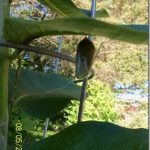
Success on the Bena Farm!
Best of all was the picture of the Monarch Chrysalis from friends, Nancy and Gordon Bena found on their farm. Let’s keep encouraging habitat for insects that form the basis of life for many other creatures.
by Winding Pathways | May 17, 2018 | Bugs, Garden/Yard, Nature, Pests
Creepy Crawlers
Even before Lyme disease created a serious tick-borne health hazard no one wanted ticks crawling on them. We sure don’t want them at Winding Pathways and because our yard has tall grass, shrubs, and a woodland we have tick habitat.
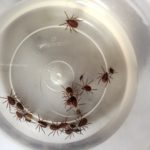
Collection of ticks
A few years ago, Rich contracted Lyme Disease caused when a tick injected bacterium into him. Thanks to a wise physician and effective antibiotics he was cured, but it’s possible to get Lyme Disease again and again. We’re more cautious about avoiding ticks now.
Ticks of many species live throughout most of the United States. They’re common in brushy, grassy, and woodsy habitat but they also love living in yards. It’s possible for a tick to enjoy a human meal even if that person never leaves a mowed yard.
Natural Tick Predators
Although naturalized yards are sometimes good tick habitat they also attract tick predators that love to snack on the tiny invertebrates. Many small birds, including warblers, wrens, and brown creepers among them quickly convert any tick they find into lunch.
Possums Are Us!
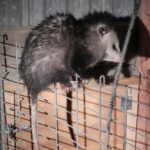
Opossums groom themselves carefully.
A newly understood tick-lover is the common opossum. Many people consider this ancient marsupial a homely animal and would prefer to not have one in their yard, but they might want to rethink this. According to the Carey Institute, opossums are tick vacuum cleaners. As they walk through a yard ticks hitch a ride, thinking they will be able to burrow into the animal’s skin and feast on warm blood. The tick doesn’t realize that possums groom their fur often and comb out ticks. These are readily eaten by the always hungry mammal. Having an opossum in the neighborhood can reduce tick numbers.
Foxes and Coyotes
Small predators, like the fox, are also valuable in tick reduction. According to a study by Dr. Hofmeester, Foxes and coyotes eat mice that ticks feed on. Ticks need three meals before they can reproduce, so more foxes and coyotes can reduce the mouse population and thus, the tick population by “…breaking the cycle of infection.”
Life Cycle
Tick numbers are also associated with climate change and abundance of food. Dr. William H. Schlesinger in an April 2018 issue of Citizen Scientist wrote about the work of Rick Ostfeld with the Carey Institute. The occurrence of ticks one year relates to mice numbers the year before, which relates to food abundance in previous years. The chain of life! And, according to Ostfeld, white-tailed deer are less implicated, unlike initial beliefs, and turkeys also appear to help reduce tick numbers. That is great news for us at Winding Pathway because the wild turkeys pretty much take over our yard at times!
Gobbling Guineas
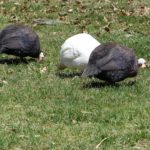
Guineas eat ticks.
A domestic bird that loves ticks is Guineas. They are tick lovers. They are African natives that have been domesticated. Elise Gallet de St Aurin, of Cheshire Moon Farms, told us the guineas that roam her farm near Atkins, Iowa, keep it clear of ticks. These attractive but loud animals roam widely, roost in trees, and eat all sorts of invertebrates, including ticks.
It’s impossible to buy or confine an opossum. But, guinea chicks can be ordered from Hoover’s Hatchery. Some people also enjoy eating guineas.
Repelling Ticks
A simple way to reduce odds that a tick will hitchhike on a person is to use repellents and chemicals that kill them. Any insect repellent containing DEET will repel ticks. Spray it heavily on the legs and arms and on clothing, especially pant legs, shoes, and socks. DEET doesn’t persist long and disappears after clothes are washed so it needs to be reapplied often.

Various forms of tick repellent.
A more permanent solution is to use a spray containing permethrin. This chemical actually kills the ticks. It lasts a long time, even through several wash cycles. It should not be applied to the skin. We spray it on our pants, socks, and shoes. One set of Permethrin-sprayed-pants remains hung in our cabin – not in the house – to put on when we are venturing in likely tick habitat.

Protect yourself with gaiters
Ticks usually access a person from down near the ground. They’re most likely to cling to pant legs or socks and then walk uphill on the skin. Tucking pants into socks makes life harder for these pesky animals, and we take it one step further. We bought a pair of tick gaiters from Forestry Suppliers, Inc. They cost about $11 and fit over shoes and pant legs, forming a tight seal.
Tick Checks
Doing a “tick check” is important. After being outside take a hot sudsy shower and check the body over for ticks. Fortunately, they usually wander around on the skin for several hours before burrowing in. A tick that has not penetrated the skin won’t spread disease and often is simply washed down the drain. Launder the clothes right away.
Ticks deserve respect. They can spread serious disease and they lurk where people often go. Don’t let a fear of ticks keep you inside. Go outside and play but take precautions to reduce the chances of catching a tick-borne illness.
by Winding Pathways | Oct 19, 2017 | Bugs, Nature
At Winding Pathways, we take joy in fall’s colorful leaves, cool days, and clear air, but we know insects are on the move.
Box Elder Bugs, Asian Beetles, other insects and spiders, and mice all sense that frigid air is on the way and seek shelter from the cold. Houses offer secure nooks and crannies to hide in and central heat to keep them toasty warm. Houses also imitate natural wintering places. Asian beetles, for example, naturally winter in the cracks of rock outcroppings. So, a house makes a perfect substitute.

Filling a Crack
Homeowners have options for reducing winter insect infestations. Many turn to insecticides when they spot beetles or bugs clustering on interior windows and walls. We avoid poison and opt for nontoxic solutions.
At Winding Pathways, we simply make it hard for bugs and mice to enter. We can’t keep all of them out but we greatly reduce their numbers. Here’s what we do before the first frost:
- Load a tube of exterior caulk into our caulking gun and inspect our house’s exterior. We squirt caulk into every crack and hole in the siding. Likely bug entry points are where wires, cables, and pipes enter the house and around door and window frames. Often old caulk has split or fallen out, so we replace it. We also inspect thresholds to make sure there is no space beneath doors for bugs to enter. Sometimes we need to replace weather stripping around doors and windows.
- Keep most firewood outside. We used to bring several days’ worth of firewood inside to make feeding our woodstove convenient but insects, like mosquitoes, hitchhiked on the cordwood and then roamed around the house. We now keep the wood in the cold just outside the door and only bring in a few pieces at a time when we need to feed the fire.
- There’s an added benefit to excluding insects and mice. The holes and cracks they use to squeeze into the house also invite in winter’s cold air. Sealing them up keeps the house warm and lets us use less fuel in our furnace and wood stove.
- Cleanse houseplants. We move some houseplants outside for the summer and bring them back indoors before the first frost, but insects can ride the plants into our home. To prevent this, we carefully clean and repot plants. Master Gardener, Tina Patterson, had an excellent column in The Gazette, Living Section, Sunday, October 1, 2017, that describes in detail ways to safely clean your plants and keep them healthy inside all winter. We have reprinted this with permission of the Gazette, Linn County Master Gardeners Program, and Tina Patterson.
FROM THE GROUND UP | LINN COUNTY MASTER GARDENER
Don’t bring in bugs with those summer plants, By Tina Patterson, Iowa State University Extension
Time to bring in those houseplants that have been soaking up the sun outside all summer. As temperatures drop, it is a good idea to make sure they make the trip alone. Bugs and spiders and even tree frogs have made their way into my house before I learned a couple of little tricks to keep them at bay. Trevor the tree frog hid in the soil of a lemon tree only to pop out one warm winter afternoon. Before you bring pots into your home, prep them for the trip. A large bucket of water with a mild soap without degreaser or detergent should do it. Trim off damaged leaves while inspecting for insect eggs on the undersides. Submerge the pot into the bucket and let it sit for 10 to 15 minutes. This should be long enough for any bugs lurking under the soil line to leave.
After removing, let it drain. Scrub the outside and bottom of the pot with a stiff brush to remove dirt and possible bugs. Rinse foliage that did not getsubmerged with a slow hose. Don’t be concerned about soil floating out of the pot. Just top it off with fresh soil once it has drained. Skim any leaves or soil that floats free. You can soak four to five pots in the same water before refreshing.
If you suspect insects deep in the soil or the plants are in need of a fresh pot, it might be a good idea to remove them from their pots, rinse the soil off the root system, let them soak for 10 to 15 minutes and repot in a fresh pot with fresh soil. Boston ferns are good candidates for this because their roots can benefit from a good long soak before coming indoors for the cold months.
Another method for dealing with potential insects is to give them a one-two punch by adding a systemic insecticide that may keep pests where they belong. Added to the soil and watered in, systemic pesticides are water soluble and are absorbed by the tissues of the plant to reach the leaves, flowers, fruit and roots. One fairly simple remedy is one part 3 percent hydrogen peroxide mixed with four parts water, which will drastically reduce gnats in your pots.
Physical traps can help to cut the insect population down to size. Yellow sticky traps or insect tapes are good for fungus gnats that live in the first inch of soil. Keep air moving on well-lit plant shelves. It will help keep mealy bugs and aphids away.
With a little prep work, your plants will be healthy and happy through the winter months – and relatively bug free.
For questions, call the Linn County Extension Master Gardener Hortline at (319) 447-0647.
by Winding Pathways | Sep 18, 2017 | Bugs, Nature
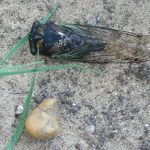
Bumper year for cicadas.
As summer winds down, our warm weather has continued in the upper Midwest and insects are having a heyday. Cicadas still call and Katydids make quite a racket at night. Behind all these summer sounds is the high pitched “cheek-cheek-cheek” of crickets. Mosquitoes persist as do any number of tiny biting insects the gravitate to open skin.
Several interesting and helpful insects, however, capture our attention. Donna, a walker on Rich’s “100th Circuit” walk around Cedar Lake shared pictures of the Digger Wasps in her yard. What fascinating insects!
Grasshoppers and Praying Mantis catch our eye because the first can hop incredible distances and the second has such an unusual shape and seem to appear only this time of year. The ubiquitous Asian Lady Beetles that bite and stink and Box Elder Bugs so aptly described as having “no where to go and all day to get there” are massing to enter our warm homes for the winter.
-
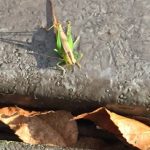
-
Grasshoppers are considered among “…the oldest living group of chewing herbivorous insects.”
-
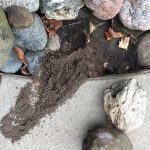
-
The Digger Wasp makes and then covers over tunnels.
-
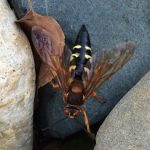
-
Digger Wasps are benign insects.
-
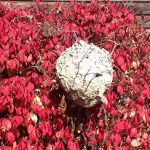
-
Camouflaged all summer, this nest now stands out against the red foliage.
-
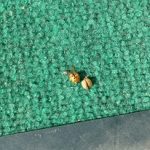
-
These “pretender” lady bugs invade homes each fall.
-
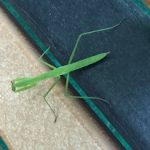
-
Praying Mantis live in temperate and tropical climates.
Winding Pathways invites readers to take a few minutes to learn about and then go out and observe these fascinating denizens of late summer and early fall. You Tube has great videos of these insects and we’ve cited several sources above. We even learned that people can and do eat some of these crunchier critters.
by Winding Pathways | Sep 14, 2017 | Bugs, Nature
Every once in a while an enormous wolf spider startles us when we go downstairs and flip on a light. We call him “Wolfie”. Fortunately, most of the time he (Wolfie might be a she) stays out of sight and is helpful because (s)he eats other critters that inhabit homes with humans.
Spiders are just about everywhere. At least 45,700 species have been identified with new ones found every year. Of all orders of living things spiders are seventh in total diversity. They live on all continents except Antarctica and in nearly every habitat except the air and salt water. Too many myths surround spiders and the stories grow around October – Halloween month. Actually, August and September in many parts of the US are prime arachnids months.
Spiders are in everyone’s home and yard. Most are tiny, harmless to humans and stay out of sight. We are most aware of spiders in the yard on mornings after a heavy dew when the lawns are carpeted with ” fairy napkins.” This is the work of funnel spiders that eat pesky insects.
All spiders share common features. Although often called “bugs” or insects spiders are arachnids that have eight legs. Insects have but six. All spiders, with possibly one exception, are carnivorous. They kill prey, which often is insects, with venom.
While we think of all spiders as predators, they themselves are an important prey species for other animals. Spot a warbler or brown creeper working its way along a tree and it’s probably seeking tiny spiders hidden in cracks in the bark or on leaves. For many birds a spider meal is simply delicious.
Spiders live in houses for good reason -food and shelter! It’s a wild world outside and plenty of insects, usually tiny and unseen, share the house with humans. They provide spiders with food. Houses are full of cracks and crevasses, perfect places for both insects and spiders to hide. Basements are usually humid, creating a perfect environment for small creatures, and when cold weather comes the furnace warms people and the insects and spiders that share the house.
Everyone has heard about Black Widow and Brown Recluse Spiders. These species can pose a health threat to people, but they are shy and rarely encountered especially in the upper Midwest.

Spider bites are painful.
Other spider species might also bite and inject venom. While not deadly, these bits can be uncomfortable Once after we returned from having been gone from the house for several days, Marion got nailed on her legs by a spide . She donned a pair of pants that had been hanging in a closet. Perhaps sensing a lack of activity, and finding the pants a comfy place to live, a spider had taken up residence in them. When disturbed by Marion’s putting on the pants, the spider defended itself by biting.
A doctor visit confirmed the bites. Antibiotics took care of the swelling and stinging. But, even two months later the healed over skin shows the discoloration of the bites. So, we did use spray to control any more arachnids from making themselves too comfortable in our home.
Late summer and fall are the best seasons to enjoy beautiful spider webs. At Winding Pathways, we often are graced by gorgeous intricate vertical webs strung between tall prairie grass. When dew covered in early morning, they are wondrous structures. Shelf spiders make horizontal webs, often on lawn grass, to trap insects. Our favorite, “Hawkeye” spider, really the black and yellow garden spider, weaves an orb web and makes short work of pesky garden insects. “Skinny-legged” spiders that often perch high in corners of rooms are harmless to people and keep insects that fly in open doors well at hand by trapping and eating them. Although webs are the most visible evidence of spiders many species don’t make them and rely on stealth and speed to catch prey directly.
Many people fear spiders, but they are remarkable, common and amazing animals that help keep insect numbers muted and usually don’t create problems for people.
-
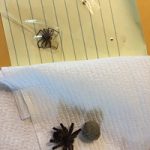
-
Arachnids around us
-
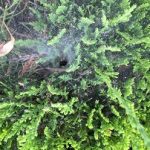
-
This beneficial spider controls insects in the yard.
by Winding Pathways | Jun 1, 2017 | Bugs, Nature, Wonderment
Reminiscing on some Haikus from the past. These seemed a good way to honor spring and welcome summer.
March
Quivering seed pods
Last year’s fruit, This year’s promise
Red buds produce life.
April
April ‘to Open’
Birds beckon, flowers unfold
Hope, re-birth, re-new.
May
Dampness Awakens.
Slow green shoots appear and grow.
Spring bursts in splendor.
How goes butterfly
So gaily in morning dew.
Quiet. Elusive.
Surf booms, with great roar.
Coquinas ride waves to rest
On white, clean beaches.
Pelicans I
Spring aerial art.
Wheeling, gliding all in sync
Pelicans migrate.
Pelicans II
Spring aerial art
Banks, wheel. Dive. Glide in sync
Pelicans migrate.
Mountain tall, distant
Shelters small creatures that live
In harmony there.
Laughter tumbles free,
From souls to the earth.
Children, living gifts.
Understand
Begin where we are
Understanding nuances
Plain talk ease nerves.
-
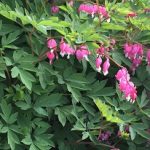
-
Bleeding Hearts
-
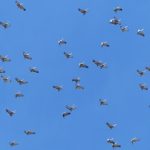
-
Wheeling overhead
-

-
Rolling a log.
-

-
Butterfly on flower





















